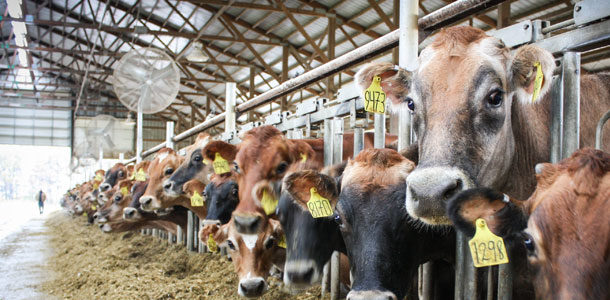This article was #10 of the Top 25 most well-read articles on www.progressivedairy.com in 2014. It was published in the April 4, 2014 Extra e-newsletter. Dr. Gary Oetzel at the University of Wisconsin – Madison gave a few pieces of advice for monitoring health in the fresh cow pen. Headlocks are a must among this group, as they allow employees to monitor feed intakes, cow behavior and watch for visual signs of sickness or infection.
:
It’s time for a little spring cleaning, so why not freshen up your fresh pen? Dr. Gary Oetzel from the University of Wisconsin – Madison School of Veterinary Medicine shared these tips for identifying problems in the postfresh pen during the Professional Dairy Producers of Wisconsin (PDPW) Business Conference last month.
1. Provide plenty of headlocks in the postfresh pen
Oetzel emphasizes that headlocks are a must. “We can never manage fresh cow health well if we do not have headlocks in that postfresh group,” he says. “Make this an extremely high priority.”
Headlocks should be set so every cow can lock up. On average, each cow needs 30 inches of bunk space, yet most headlocks measure 24 inches. In order to provide 30 inches of space, 80 percent is as many cows as we can put into that pen before the headlocks are full.
Barns that do not have headlocks in this critical group risk putting both cows and workers in stressful situations. It is difficult for a veterinarian to thoroughly examine a cow from the palpation rail; further, individual chutes may also block full access to the animal for checking her heart and lungs.
“If you have to move fresh cows to an individual chute, you have penalized the cow and workers in the process,” he adds.
2. Time the first milking of the day with fresh feed delivery
Oetzel recommends synchronizing the day’s first milking with a fresh batch of TMR delivered to the bunk.
“This has to be consistent,” he explains. “Parlors break down, mixers break down. But if you get off-sync on this one, you are going to pay in cow health and performance, plus you will have more trouble identifying your sick cows.”
This timing is critical for observing appetite. “Appetite is the key driver for how we identify [sick] cows early,” he adds.
3. Look for the “holes”
Five to 10 minutes after the last cow has returned from the parlor, walk the length of the pen in front of the cows before walking behind them. Pay special attention to the feed “holes” by each cow.
“This is how you monitor appetite,” Oetzel says. If a fresh cow has not touched her feed, this may be a sign that she is off. In many barns, pen managers can pull up cow data to determine how many days in milk a particular cow may be, thus, further indicating her likelihood of disease.
4. Look beyond the bunk
The trained eye can pick up on other visual signs of sickness through observation of the individual cow. Oetzel notes, “It’s an excellent skill that needs to be cultivated and rewarded among your employees.”
Overall attitude – eyes, ears, stance – can indicate illness, as can changes in behavior. If a cow that normally locks up after milking chooses instead to lie down, that is a reason to examine her.
5. Check out the rearview
After observing cows from the front, take a walk behind them. From here, you can evaluate vaginal discharge and manure consistency. Some herds may sleeve cows that could be problematic. Oetzel strongly discourages vaginal exams by owners or workers.
While veterinarians may do so on certain occasions, there is a danger of pushing bacteria forward into the uterus, which can do more damage to cows trying to heal after calving trauma.
“We actually find very little value in doing vaginal exams on fresh cows,” Oetzel says. PD
PHOTO
According to Dr. Gary Oetzel, headlocks are a key component of the postfresh pen. Every cow should be able to lock up as she comes to the bunk after milking, allowing herd managers to monitor appetite among this high-risk group and examine any cows exhibiting “off” behavior. Photo by Peggy Coffeen.
Peggy Coffeen
Editor
Progressive Dairyman







